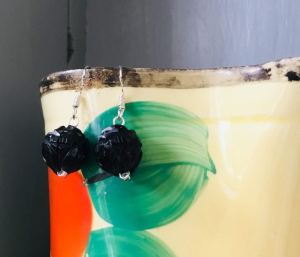I love Whitby Jet – it’s dark, gothic beauty has real character and stories to tell. Over the last 300 years, it has mainly been used for mourning jewellery, especially favoured by the Victorians. Whitby Jet was lightweight and easy to carve, so lent itself perfectly to making jewellery to memorialize lost loved ones. I often use recycled and reclaimed antique Whitby Jet beads for our vintage recycled bead earrings as Whitby Jet jewellery is a lovely thing to collect and wear. So, here’s a few things that are good to know if you want to do that…
What is Whitby Jet?
Whitby Jet is an organic material that is naturally formed from ancient fossilised wood such as the Monkey Puzzle & Chile Pine. Whitby Jet is also know as Black Amber and is 182 Million years old. It is formed when prehistoric wood gets washed up into a body of water and becomes covered by organic sediment. The pressure of the water and sediment over millions of years compacts the wood and slowly transforms it into what we know as Whitby Jet.
The layers of jet are usually trapped deep below the earth’s surface, in the layers of sedimentary rock, but, there are a few, rare places where those layers or seams of jet are found on or near the surface and Whitby is one of them. Jet is also found in small areas in Northern Spain, Poland, Ezurum in Turkey and in the USA in Utah, Colorada and New Mexico.
History of Whitby Jet
Whitby jet was discovered, mined and carved in Britain from the Neolithic period onwards and often appeared as beads and decorations, it was very popular with Romans in the Third centuary who felt it had magical protective & healing properties and used it for a variety of decorative objects, including hair pins.
Whitby Jet fell in and out of fashion, but it’s use continued, mainly as monks rosery beads. In 1808 a boat captain observed two men in Whitby hand carving beads and crosses from Whitby Jet. While the men, John Carter and Robert Jefferson, used files and handmade tools to work Whitby Jet, Captain Tremlett, had experience turning amber on a lathe to produce pieces, wondered if the same could be done with Whitby Jet.
With the help of a turner, Mathew Hill, they successfully lathed Whitby Jet, the Captain hired him as a jet turner and the first jet workshop in Whitby was started. The light-weight nature of Whitby jet and it’s sombre apperence combined with the sadly comon occurance of death meant that the production of mourning jewellery ensured that the industry grew. By 1850, there were more than 50 Jet workshops in Whitby, producing beads, mourning jewellery and other items & The Great Exhibition of 1851 presented Whitby Jet to the world.
In 1861 Prince Albert, Queen Victoria’s husband died and she immersed herself in full, deep mourning, including Whitby Jet mourning jewellery. Immediately, Whitby jet became really fashionable, it was so popular that the demand for it rapidly out-stripped the limited supply that Whitby could produce.
At one point, Whitby Jet production meant work for over 1,400 people and produced an annual profit of over £100,000, which is approximately three million pounds by today’s standards.
As a result of the sky-rocketing demand, French Jet or Parisian Jet was developed to inexpensively re-produce the exclusive and expensive Whitby Jet, French Jet was Black glass and it allowed the mass-production of mourning jewllery. Whitby Jet & French Jet remained popular until the the 1920’s by which time it was mainly used as beads in flapper necklaces – the long waist-length necklaces worn by flapper girls during the roaring Twenties.
French jet jewellery coming onto the market, combined with cheaper imported Spanish jet, lead to the collapse of the industry by the mid-1900s.

Collecting & Identifying Whitby Jet.
In recent years Whitby Jet has enjoyed renewed interest and there are a number of Jet workshops in Whitby. There is also a strong interest in authentic antique Whitby Jet jewellery – and its substitutes.
When collecting jet it’s useful to know exactly what you’re buying, especially as antique Whitby Jet pieces can hold their value quite well, but, only if they are actually Whitby Jet. So the question is how do identify Whitby Jet.
Whitby Jet is a deep Black colour, it is light weight and warm-ish to the touch, it is shiney, glossy and smooth. The microstructure of Whitby Jet, resembles the original wood, and this can be seen under 120× or greater magnification. The detailing carved into the piece can help identify if it is genuine jet. Whitby Jet usually has shallow relief, simple carved details, such as straight carved lines, as it can shatter when the detailing is too fine. Whitby Jet will also either float or sink slowly when placed in water.
One great way to identify Whitby Jet is being to clearly identify when a piece is not Whitby Jet and what it might be.
Modern Plastic – will be very glossy, very light weight and it may have seams and creases from the pressing process. Pieces of imitation jet in plastic are often very intricate with very fine detailing – rarely seen in genuine Whitby Jet as it fractures when it is carved into very fine details.
Spanish (soft) Jet – quite a lot of soft jet was imported into the UK during the late 1800’s and early 1900’s. However, as is was softer than Whitby Jet much of it has cracked and broken over the years and so it is rare to find it. Soft jet will have a cracked or crackled appearance.
Black glass – known as French Jet, Parisian Jet or Vauxhall Glass was commonly used as a Whitby Jet substitute during the peak of jet’s popularity. Glass feels heavy and cool to the touch and Whitby Jet is not, so if the piece is slightly weighty and cool to the touch it is French Jet (glass) not Whitby Jet. Also, if you carefully tap a piece of Whitby Jet against your teeth you’ll hear a soft tap, but if tap French jet or other glass beads against your teeth you’ll feel or hear a sharped, harder sound (please be very gentle).
Ebonite or Vulcanite (an early type of rubber) was also used as a Whitby Jet substitute and it looks and feels very similar to jet, but, it fades and loses its shine over time, so if you piece is not Jet Black and shiney (yes, this is where that phrase comes from) then it’s not Whitby Jet.
Anthracite (hard coal) is similar to Whitby Jet, and has been used to imitate it. When rubbed against unglazed porcelain, Anthracite will leave a Black mark and Whitby Jet will leave a chocolate Brown mark.
Bog Oak can be easily mistaken for Whitby Jet, but, Bog Oak has a visable wood grain when you look closely and the surface won’t be very polished, unlike the smooth, lustrous appearance of Whitby Jet.
Carved horn can be also look very similar in Whitby Jet. It also feels smooth and lightweight too. However, dyed horn, will appear slightly translucent along its edges when held up to the light.
Also, in some cases Whitby Jet off-cuts were mixed with glue and molded into jewellery but Whitby Jet is smooth and shiney, so if the piece is dulled, rough, mottled or fragmented in appearence, it is not solid Whitby jet.
Caring for Whitby Jet.
Whitby Jet is beautiful to collect and wear and keeping it looking lovely is easy. To clean Whitby Jet, simply wash carefully with warm water and a mild detergent, (don’t soak the piece in water), rinse with fresh water and pat dry with a soft towel and leave to air dry fully. Once it’s dry, give it a gentle wipe with a tiny amount baby oil on a piece of cotton wool, to bring back its high polish. Don’t forget to store your Whitby Jet jewellery separately from other items, so that it doesn’t get scratched or damaged.
Want to Know More About Whitby Jet?
I hope you find this information useful and it’s a good starting point for learning about Whitby Jet and if you’d like to find out more then this book is a great read.

Please note – this blog contains affiliate links and if you purchase through them, I receive a small commision, that helps me pay my bills, so thank you for your support!
Thank you, have a lovely day & enjoy!
Sarah x
Sign up for our blog! – It’s a bit: lifestyle… travel… jewellery… Bronte… eco… art… literature… wellbeing & more…

- Happy Halloween! The Blood-Curdling Bronte Sisters & Horrifying Haworth!A spooky halloween post about the Bronte Sisters and the home Haworth.
- Going a bit Gothic …..As the days shorten the weather here in Yorkshire gets a bit gothic, especially as halloween draws near and I’ve got to say I do love it! We’ve always had a soft spot for all things dark and brooding and… Read more: Going a bit Gothic …..
- 10 Things to do this Autumn – that will help you feel great!The Autumn is officially upon us! The nights are drawing in really fast now and as we lose the daylight, I find it challenging to maintain my mood. So, as the temperature drops, the leaves turn to Red and Gold,… Read more: 10 Things to do this Autumn – that will help you feel great!

2 thoughts on “Whitby Jet.”
Comments are closed.